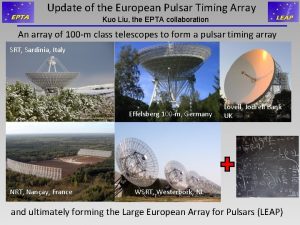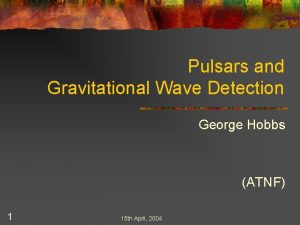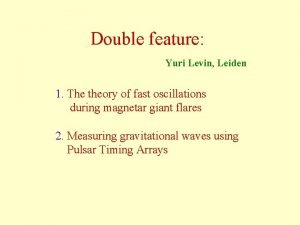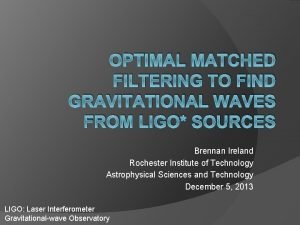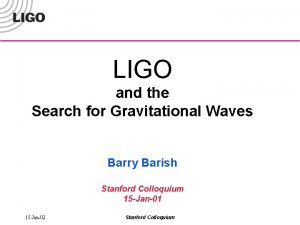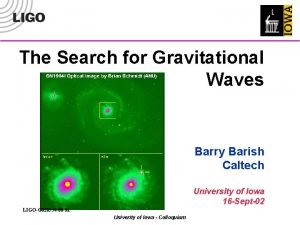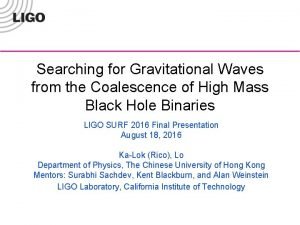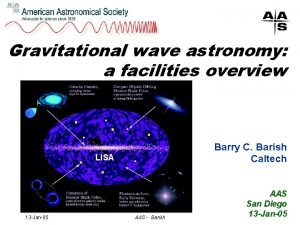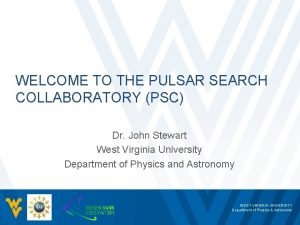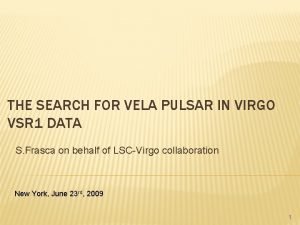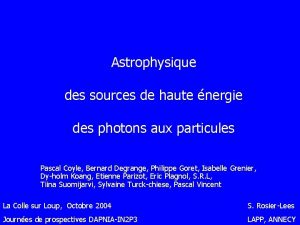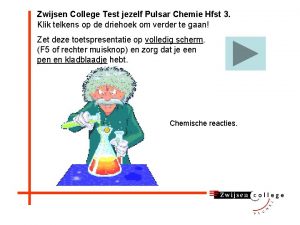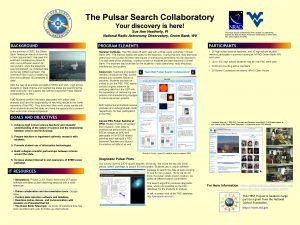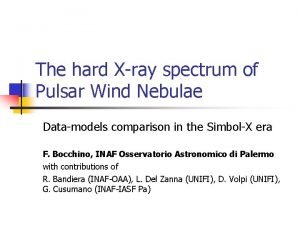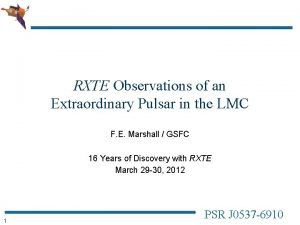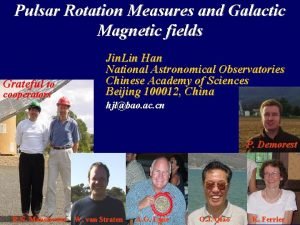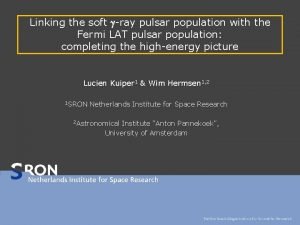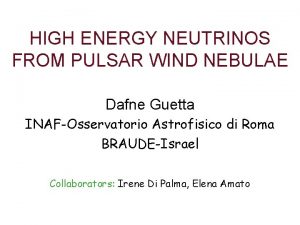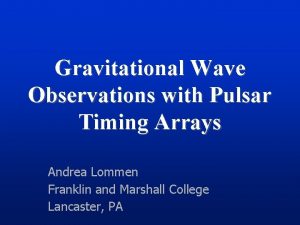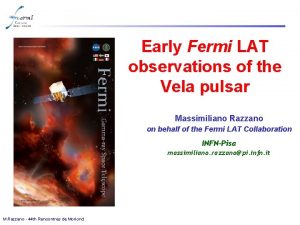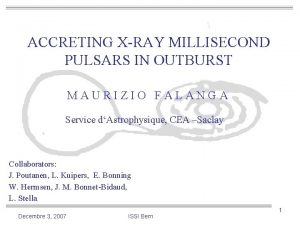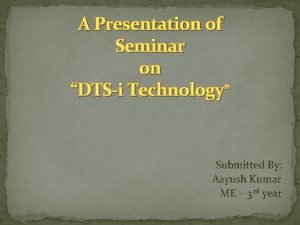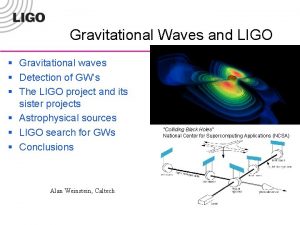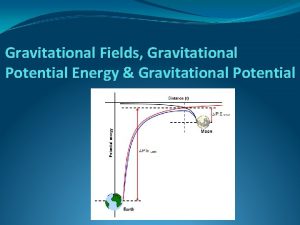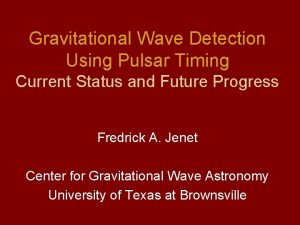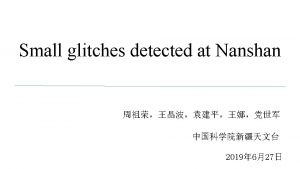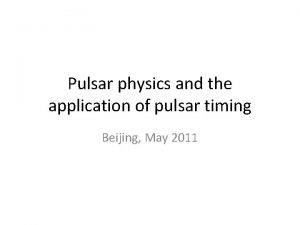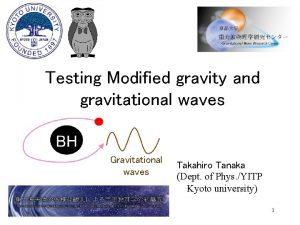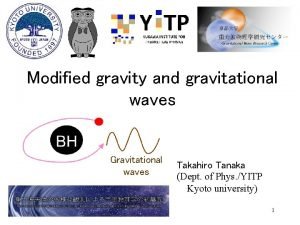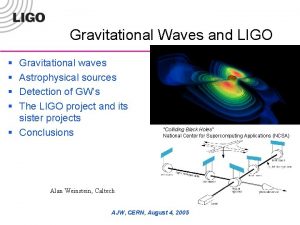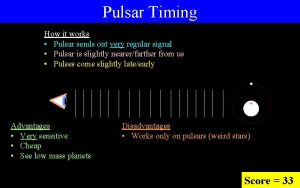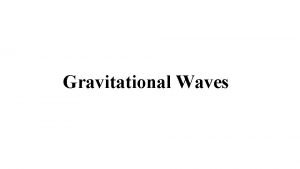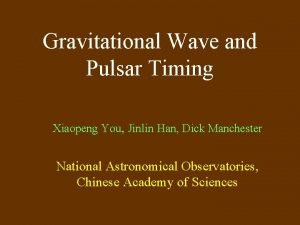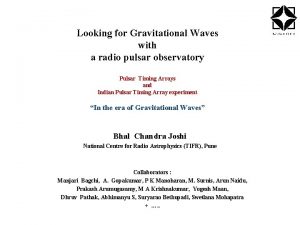Pulsar Timing and the Detection of Gravitational Waves








































- Slides: 40

Pulsar Timing and the Detection of Gravitational Waves R. N. Manchester CSIRO Astronomy and Space Science Sydney Australia Summary • Review of pulsar properties and timing • Binary pulsars and GR tests • Detection of gravitational waves • Pulsar Timing Array (PTA) projects • Current status and future prospects

Spin-Powered Pulsars: A Census • Currently 2213 known (published) pulsars • 2050 rotation-powered disk pulsars • 213 in binary systems • 302 millisecond pulsars • 142 in globular clusters • 8 X-ray isolated neutron stars • 20 AXP/SGR • 21 extra-galactic pulsars Data from ATNF Pulsar Catalogue, V 1. 46 (www. atnf. csiro. au/research/pulsar/psrcat) (Manchester et al. 2005)

Pulsar Origins Pulsars are believed to be rotating neutron stars – two main classes: Normal Pulsars: • Formed in supernova • Periods between 0. 03 and 10 s • Relatively young (< 107 years) • Mostly single (non-binary) (ESO – VLT) Millisecond Pulsars (MSPs): • MSPs are very old (~109 years). • Mostly binary • They have been ‘recycled’ by accretion from an evolving binary companion. • This accretion spins up the neutron star to millisecond periods. • During the accretion phase the system may be detectable as an X-ray binary system.

Pulsars as Clocks • Neutron stars are tiny (about 25 km across) but have a mass of about 1. 4 times that of the Sun • They are incredibly dense and have gravity 1012 times as strong as that of the Earth • Because of this large mass and small radius, their spin rates and hence pulsar periods – are extremely stable e. g. , PSR J 0437 -4715 had a period of : 5. 757451831072007 0. 00000008 ms • Although pulsar periods are very stable, they are not constant. Pulsars lose energy and slow down • Typical slowdown rates are less than a microsecond per year

Measurement of pulsar periods • Start observation at a known time and average 103 - 105 pulses to form a mean pulse profile • Cross-correlate this with a standard template to give the arrival time at the telescope of a fiducial point on profile, usually the pulse peak – the pulse time-of-arrival (To. A) • Measure a series of To. As over days – weeks – months – years • Transfer To. As to an inertial frame – the solar system barycentre • Compare barycentric To. As with predicted values from a model for the pulsar – the differences are called timing residuals. • Fit the observed residuals with functions representing errors in the model parameters (pulsar position, period, binary period etc. ). • Remaining residuals may be noise – or may be science!

. The P – P Diagram P = Pulsar period P = d. P/dt = slow-down rate . . • For most pulsars P ~ 10 -15 . • MSPs have P smaller by about 5 orders of magnitude • Most MSPs are binary, but few normal pulsars are . • tc = P/(2 P) is an indicator of pulsar age • Surface. 1/2 dipole magnetic field ~ (PP) Great diversity in the pulsar population! Galactic Disk pulsars

Sources of Pulsar Timing “Noise” Ø Intrinsic noise • Period fluctuations, glitches • Pulse shape changes Ø Perturbations of the pulsar’s motion • Gravitational wave background • Globular cluster accelerations • Orbital perturbations – planets, 1 st order Doppler, relativistic effects e d i w a f o • Wind from binary companion s e b o r a • Variations in interstellar dispersion ful p n e r m o n • Scintillation effects powe e h p e r l a a c s Ø Perturbations of the Earth’s motion i r s a y s l h p o P • u. Gravitational wavef background r t s a • Errors in the Solar-system ephemeris o e g n a Ø Clockrerrors Ø Propagation effects • Timescale errors • Errors in time transfer Ø Instrumental errors • Radio-frequency interference and receiver non-linearities • Digitisation artifacts or errors • Calibration errors and signal processing artifacts and errors Ø Receiver noise

PSR B 1913+16: The First Binary Pulsar Ø Discovered at Arecibo Observatory by Russell Hulse & Joe Taylor in 1975 Ø Pulsar period 59 ms, a recycled pulsar Ø Doppler shift in observed period due to orbital motion Ø Orbital period only 7 hr 45 min Ø Maximum orbital velocity 0. 1% of velocity of light Relativistic effects detectable!

Post-Keplerian Parameters: PSR B 1913+16 Given the Keplerian orbital parameters and assuming general relativity: • Periastron advance: 4. 226598(5) deg/year Ø M = mp + mc • Gravitational redshift + Transverse Doppler: 4. 2992(8) ms Ø mc(mp + 2 mc)M-4/3 • Orbital period decay: -2. 423(1) x 10 -12 Ø mp mc M-1/3 First two measurements determine mp and mc. Third measurement checks consistency with adopted theory. Mp = 1. 4398 0. 0002 Msun Mc = 1. 3886 0. 0002 Msun Both neutron stars! (Weisberg, Nice & Taylor 2010)

Orbital Decay in PSR B 1913+16 • Orbital motion of two stars generates gravitational waves PSR B 1913+16 Orbit Decay • Energy loss causes slow decrease of orbital period • Predict rate of orbit decay from known orbital parameters and masses of the two stars using GR • Ratio of measured value to predicted value = 0. 997 +/- 0. 002 ØConfirmation of general relativity! ØFirst observational evidence for gravitational waves! (Weisberg , Nice & Taylor 2010)

PSR J 0730 -3039 A/B The first double pulsar! Ø Discovered at Parkes in 2003 Ø One of top ten science breakthroughs of 2004 - Science Ø PA = 22 ms, PB = 2. 7 s Ø Orbital period 2. 4 hours! Ø Periastron advance 16. 9 deg/yr! (Burgay et al. , 2003; Lyne et al. 2004) Highly relativistic binary system!

Measured Post-Keplerian Parameters for PSR J 0737 -3039 A/B GR value Measured value . Periast. adv. (deg/yr) . - Grav. Redshift (ms) 0. 3842 Pb Orbit decay r Shapiro range ( s) s Shapiro sin i 16. 8995 0. 0007 0. 386 0. 003 Improves as T 1. 5 -1. 248 x 10 -12 (-1. 252 0. 017) x 10 -12 T 2. 5 6. 15 0. 99987 6. 2 0. 3 0. 99974 +16 -39 T 0. 5 GR is OK! Consistent at the 0. 05% level! Non-radiative test - distinct from PSR B 1913+16 (Kramer et al. 2006)

The Double Pulsar: Update • PSR J 0737 -3039 B has disappeared! • Beam has moved away due to orbital precession • Expected to return in 5 – 10 years c i t s i v i t a l re f o n o i t ec t e f d o t r n o f e s m t re ec u p s s a o r e p m d nd • Continued timing a Goo at n o i t a ia m t r r o e f n e i d f t o i Parkes and GBT has t n orb e m o m pulsar refined relativistic parameters • Now limits deviations from GR to 0. 02% (Kramer et al. 2013)

Detection of Gravitational Waves • Prediction of general relativity and other theories of gravity • Generated by acceleration of massive object(s) • Astrophysical sources: Ø Inflation era fluctuations Ø Cosmic strings Ø BH formation in early Universe Ø Binary black holes in galaxies Ø Coalescing neutron-star binaries Ø Compact X-ray binaries (K. Thorne, T. Carnahan, LISA Gallery)

A Pulsar Timing Array (PTA) • With observations of many pulsars widely distributed on the sky can in principle detect a stochastic gravitational wave background • Gravitational waves passing over the pulsars are uncorrelated • Gravitational waves passing over Earth produce a correlated signal in the TOA residuals for all pulsars • Requires observations of ~20 MSPs over ~10 years; could give the first direct detection of gravitational waves! • A timing array can detect instabilities in terrestrial time standards – establish a pulsar timescale • Can improve knowledge of Solar system properties, e. g. masses and orbits of outer planets and asteroids Idea first discussed by Hellings & Downs (1983), Romani (1989) and Foster & Backer (1990)

Ø Clock errors All pulsars have the same TOA variations: monopole signature Ø Solar-System ephemeris errors Dipole signature Ø Gravitational waves Quadrupole signature Can separate these effects provided there is a sufficient number of widely distributed pulsars

Detecting a Stochastic GW Background Hellings & Downs correlation function Simulation of timingresidual correlations among 20 pulsars for a GW background from binary super-massive black holes in the cores of distant galaxies To detect the expected signal, we need ~weekly observations of ~20 MSPs over ~10 years with TOA precisions of ~100 ns for ~10 pulsars and < 1 s for the rest (Jenet et al. 2005, Hobbs et al. 2009)

Major Pulsar Timing Array Projects Ø European Pulsar Timing Array (EPTA) • Radio telescopes at Westerbork, Effelsberg, Nancay, Jodrell Bank, (Cagliari) • Normally used separately, but can be combined for more sensitivity • Timing 27 millisecond pulsars, 5 with s. To. A < 2 s, data spans 5 - 18 years Ø North American pulsar timing array (NANOGrav) • Data from Arecibo and Green Bank Telescope • Timing 17 millisecond pulsars, 16 with s. To. A < 2 s, data spans ~ 5 years Ø Parkes Pulsar Timing Array (PPTA) • Data from Parkes 64 m radio telescope in Australia • Timing 22 millisecond pulsars, 16 with s. To. A < 2 s, data spans 3 – 19 years Observations at two or three frequencies required to remove the effects of interstellar dispersion

The Parkes Pulsar Timing Array Collaboration Ø CSIRO Astronomy and Space Science, Sydney Dick Manchester, George Hobbs, Ryan Shannon, Mike Keith, Sarah Burke-Spolaor, Aidan Hotan, John Sarkissian, John Reynolds, Mike Kesteven, Warwick Wilson, Grant Hampson, Andrew Brown, (Jonathan Khoo), (Russell Edwards) Ø Swinburne University of Technology, Melbourne Matthew Bailes, Willem van Straten, Andrew Jameson, (Stefan Oslowski) Ø Monash University, Melbourne Yuri Levin Ø University of Melbourne Vikram Ravi (Stuart Wyithe) Ø University of Western Australia, Perth Linqing Wen, Xingjiang Zhu ØCurtin University, Perth Ramesh Bhat ØUniversity of California, San Diego Bill Coles Ø MPIf. R, Bonn (David Champion), (Joris Verbiest), (KJ Lee) Ø National Space Science Center, Beijing Xinping Deng Ø Xinjiang Astronomical Observatory, Urumqi Jingbo Wang ØSouthwest University, Chongqing Xiaopeng You

The PPTA Project • Using the Parkes 64 -m radio telescope at three frequencies, 700 MHz, 1400 MHz and 3100 MHz, to observe 21 MSPs • Observations at 2 - 3 week intervals • Regular observations commenced in mid-2004 • Digital filterbanks and baseband recording systems used to remove dispersive delays • Database and processing pipeline - PSRCHIVE programs • Timing analysis - TEMPO 2 • Studying detection algorithms for different types of GW sources (stochastic background, individual SMBHB, GW burst sources, etc. ) • Simulating GW signals and studying implications for galaxy evolution models • Establishing a pulsar-based timescale and investigating Solar system properties • Using PPTA data sets to investigate individual pulsar properties, e. g. , pulse polarisation, binary evolution, astrometry etc. Manchester et al. (2013) www. atnf. csiro. au/research/pulsar/ppta

The PPTA Pulsars All (published) MSPs not in globular clusters

PPTA Three-band Timing Residuals 50 cm 10 cm 20 cm

PPTA Data Sets • Data for 22 pulsars, currently timing 21, two started 3 years ago • PPTA data + earlier Parkes data – spans up to 19 years • Best 1 -year rms timing residuals ~40 ns (J 0437 -4715, J 1909 -3744) • DM correction is important • About half of the sample shows evidence for red noise • Rms timing residuals 0. 2 – 4 s • Not yet applied: full polarisation (MTM) fitting, frequencydependant templates Still work to do! (Hobbs 2013)

PPTA Timing Residuals • Timing data for 22 pulsars • Data spans to 19 years • DM corrections applied where available • Low-frequency (red) variations significant in about half of sample – some due to uncorrected DM variations in early data • Several of best-timing pulsars nearly white

The International Pulsar Timing Array • The IPTA is a consortium of consortia, namely existing PTAs from around the world • Currently three members: EPTA, NANOGrav and PPTA • The aims of the IPTA are to facilitate collaboration between participating PTA groups and to promote progress toward PTA scientific goals • There is a Steering Committee which sets policy guidelines for data sharing, publication of results etc. • The IPTA organises annual Student Workshops and Science Meetings – 2013 meetings will be in Krabi, Thailand, June 17 -28 • The IPTA has organised Data Challenges for verification of GW detection algorithms

IPTA Website: www. ipta 4 gw. org

IPTA Data Challenge 1 • Three types of data set (uniform sampling, white noise; non-uniform sampling, red+white noise) • All data sets have 5 -year span • Open Challenge: details of injected GW signal given. • Closed Challenge: blind detection • Data Challenge 2 planned – will have more realistic data sets and weaker injected GW signal Results for Closed Challenge, Data set 3: Organised by Rick Jenet, KJ Lee and Mike Keith

IPTA Data Sets: 39 MSPs

Detection of the GW Background • Pulsar timing arrays are most sensitive to GW signals with frequency f ~ 1/Tspan ~ few nano. Hertz • Strongest source of n. Hz GW waves is background from orbiting super-massive black holes in distant galaxies • Number of mergers per comoving volume based on model for galaxy evolution (e. g. Millennium simulation) plus model formation and evolution of SMBH in galaxies (M = binary chirp mass, q = mass ratio) (Phinney 2001; Jenet et al. 2006; Sesana 2013)

Stochastic GW Background: Distribution of SMBBH • Most of background from SMBBH in galaxies at z = 1 -2 • Biggest contribution from largest BH masses: 108 – 109 Msun Chirp mass = (M 1 M 2)3/5 (M 1 + M 2)-1/5 (Sesana et al. 2008)

Predicted Stochastic GW Background Amplitude EPTA limit 20 psrs, 100 ns 10 years = hc(1/1 yr) (Sesana 2013; van Haasteren et al. 2011)

GW Detection Sensitivity Low signal level (< white noise) High signal level (>~ w. noise) • Based on correlation analysis – Earth term only • c. IJ: Hellings-Downs coefficients • Simplified model: M pulsars, all same s (rms timing noise) • At low signal levels, S/N improves as MTb ~ MT 13/3 • At higher signal levels, S/N ~ MT 1/2 (Siemens et al. 2013)

Single Sources • Likely that many SMBH binary systems are highly eccentric • GW spectrum may be dominated by a strong individual source First GW detection by PTAs could be a single source with period <~ 1 year! (Sesana 2012)

Localisation of GW Sources (Tempo 2) • Fits quadrupolar signature to arbitrary waveforms for multiple pulsars – good for continuous or burst sources • Strong GW source injected into PPTA data sets • Grid search over sky to measure detection significance as function of position • “Blind” search: independent software for injection and detection Source detected at close to correct position (George Hobbs and Ryan Shannon)

Limiting the GW Background • Can use auto-correlations – pulsar terms contribute power to ACF • Detection statistic: Weights: Spectral model: GW signal: Expected signal for A 95 • Used six best PPTA pulsars Observed spectrum M (f. PPTA=2. 8 n. Hz) • 95% confidence limit on GW signal in data: A 95 < 2. 4 x 10 -15 Rel. energy density WGW(f. PPTA) < 1. 3 x 10 -9 W Fitted GW signal (A=1. 2 x 10 -15) (Shannon et al. 2013)

Current PPTA Limit (95% confidence) Ravi et al. 2012 (Millennium model with new BH mass function) Sesana 2013 Mc. Williams et al. 2012 A 95 = 2. 4 x 10 -15 (Shannon et al. 2013)

Predicted Stochastic GW Background Amplitude EPTA limit PPTA limit 20 psrs, 100 ns 10 years = hc(1/1 yr) (Sesana 2013, van Haasteren et al. 2011; Shannon et al. 2013)

Future Prospects • Continuing searches will increase number of known pulsars • Combination of extended PTA data sets to make IPTA should give a detection of the stochastic GW background (M ~ 35) • Very high sensitivity of FAST and SKA should allow timing of 100 – 200 MSPs Sensitivity of a PTA to a stochastic GW background 100 ns rms residuals No intrinsic red noise Black: 20 psrs Red: 50 psrs Blue: 200 psrs Plain line: 5 yrs Line with ×: 10 yrs Line with o: 20 yrs (Manchester et al. 2012) (Sesana prediction)

FAST: Guizhou China 2017 2012 2020+ SKA Mid-Frequency Array: South Africa

The Gravitational Wave Spectrum
 Pulsar timing
Pulsar timing Pulsar
Pulsar Yuri levin
Yuri levin Matched filtering gravitational waves
Matched filtering gravitational waves Gravitational waves
Gravitational waves Gravitational waves
Gravitational waves Gravitational waves
Gravitational waves Gravitational waves
Gravitational waves Compare and contrast p waves and s waves using venn diagram
Compare and contrast p waves and s waves using venn diagram What waves do not require a medium
What waves do not require a medium Similarities of mechanical and electromagnetic waves
Similarities of mechanical and electromagnetic waves What is a rainbow
What is a rainbow Long waves and short waves
Long waves and short waves Mechanical waves and electromagnetic waves similarities
Mechanical waves and electromagnetic waves similarities Mechanical and electromagnetic waves similarities
Mechanical and electromagnetic waves similarities Surface waves and body waves
Surface waves and body waves Electromagnetic and mechanical waves
Electromagnetic and mechanical waves Difference between constructive and destructive waves
Difference between constructive and destructive waves Longitudinal wave vs transverse wave
Longitudinal wave vs transverse wave Characteristics of a longitudinal wave
Characteristics of a longitudinal wave Whats a reflected sound wave
Whats a reflected sound wave Electromagnetic waves vs mechanical waves
Electromagnetic waves vs mechanical waves Seismic waves are mechanical waves
Seismic waves are mechanical waves Pulsar search collaboratory
Pulsar search collaboratory Vela pulsar
Vela pulsar Al pulsar el botón derecho del ratón, generalmente:
Al pulsar el botón derecho del ratón, generalmente: Neutralino
Neutralino Pulsar chemie
Pulsar chemie Pulsar search collaboratory
Pulsar search collaboratory Pulsar wind
Pulsar wind Pulsar
Pulsar Pulsar wind
Pulsar wind Pulsar
Pulsar Pulsar analytics
Pulsar analytics Pulsar
Pulsar Pulsar
Pulsar Pulsar wind
Pulsar wind Pulsar
Pulsar Pulsar
Pulsar Falanga
Falanga Dtsi technology
Dtsi technology
